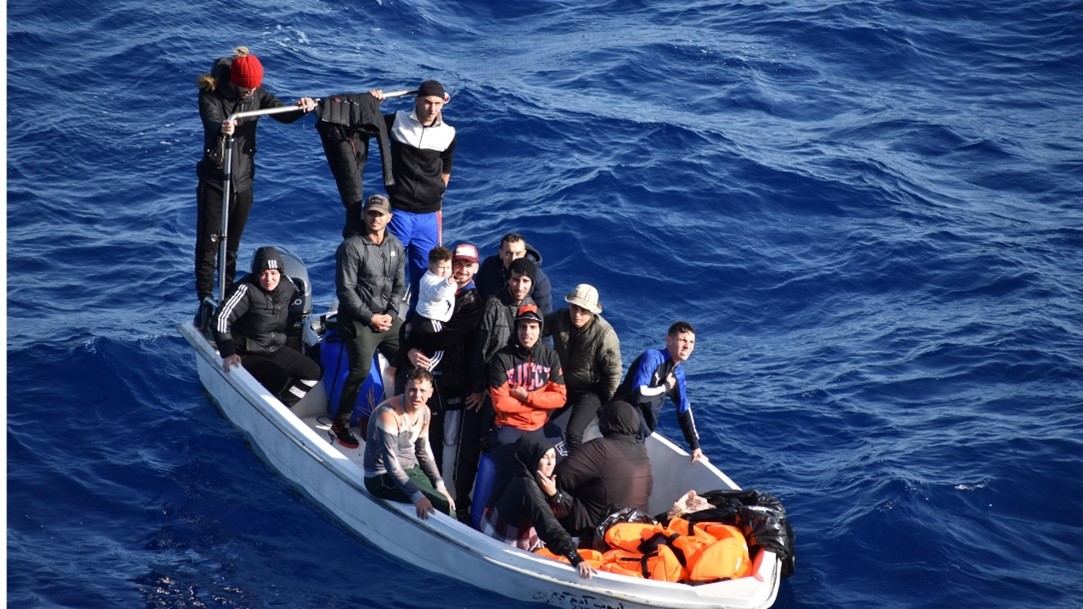In Fall 2022 I taught for Semester at Sea, an experiential university program that combines classes on ship with travel opportunities in eleven ports. This term we left Amsterdam, traveled into the Mediterranean Sea, through the Suez Canal, down the Red Sea and across the Indian Ocean. I got to see everything from the old Moorish forts outside of Lisbon and the souks of Fez, Morocco to the ruins of the Acropolis in Athens and the megalopolis of Mumbai, India. I taught a course titled "Global Studies." It is the one course required of all 450 students on board and focuses on helping them understand the places they will visit, and to put these ports into larger historical and contemporary contexts.
Three days out of Spain, I was planning on giving an introductory lecture for my class on the Mediterranean Sea migration crisis. Each year, tens of thousands of refugees take to the perilous waters of the Mediterranean in a desperate search for safety, and the seas east of Spain are one of the major crossing points from North Africa to Europe. Many attempting this crossing are fleeing the incessant wars across the Horn of Africa, Afghanistan or Syria. Others are fleeing the crippling effects of climate change- drought across North Africa and disappearing coastlines in Bangladesh and Sri Lanka. Others are fleeing political, religious and/or social persecution in their home country. They come from many places, winding up on the shores of the Sea and take to the waters, hoping to get to Europe. Tragically, every year far too many perish enroute.
Trying to convey the experience of these refugees, and the reasons they take such a desperate journey, is often difficult. The numbers are staggering but their individual stories are often lost in part because those numbers are so staggering. Government agencies and non-government organizations churn out statistics ,but the faces of the refugees lucky enough to survive the crossing and get to Europe are often hidden behind the fences of the refugee camps they wind up in or the hollow rhetoric of politicians who claim to know their situation without ever talking to them.
As I was wrestling with how to humanize the story of the Mediterranean refugee crisis for the diverse population of 450 students and numerous adult travelers that were part of the Fall voyage, I heard a student call out from the aft deck, “I think I saw something. I think it was a flare.” Those of us nearby raced to the back deck and looked out. Someone had some binoculars. Indeed, it seemed there was something out there, a boat. And it was making its way toward us. Word got to the captain, and our ship slowed its engines. Slowly, amidst choppy seas, the boat approached and we heard cries for help. It was an 18-foot rowboat with thirteen people, ten men, two women and a young child aboard.
Over the next hour and a half we circled the craft. Students were frustrated. “Why aren’t we taking them in? There is a baby on board! Who are they? Where did they come from? What’s going to happen to them?”
Eventually a Spanish coast guard boat arrived (we were a few miles inside Spanish territorial waters) and loaded the people on the boat aboard. We restarted our engines and continue heading east, across the Mediterranean. Over the next days we had endless conversations about what had happened as we tried to understand what we saw, who we saw. Seeing a boatload of refugees, in the flesh, rather than as an abstract set of statistics, made the students ask many of the same questions I wanted them to think about when I was planning to talk about the story of migrants a few days later but gave these questions an immediacy, a set of faces, that my lecture could have never done. The face of the other had broken through and the students could not think of refugees and migrants in the same way again.
It turned out, we found out while talking to our captain after we had set sail again, that indeed the refugees were likely hoping to get picked up by the Spanish coast guard. Had we had to rescue them or decided to take them on board the stipulations of maritime law would not have been allowed them to be taken to a European country and they would have presumably eventually been sent back to North Africa. Because the Spanish took them in they would be eligible to apply for refugee status in the EEC which is the goal of many of those risking this crossing. The incident turned out to be a quick immersion in the complicated legal issues that immigrants have to negotiate along with the perilous waters of the Mediterranean.
One of the most important tools an historian has is empathy; the attempt to “put yourself in the shoes of the other.” Whether trying to understand the experience of slaves crossing the Atlantic in the crammed holds of ships or the lives of Jewish families in the terrors of the Warsaw ghetto, historians reading the sources have to try and understand how people living through these events experienced them. I can’t say witnessing this incident has allowed me to fully understand the experience of these refugees but having seen their faces in that boat, I will never think of the refugee crisis in the Mediterranean Sea in the same way again.

